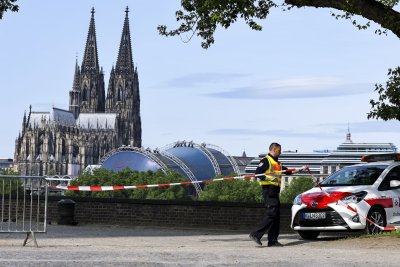Unexploded Israeli bombs threaten lives as Gaza clears debris, finds bodies | Israel-Palestine conflict News
Israeli restrictions on the entry of heavy machinery are crippling Gaza City’s efforts to clear debris and rebuild critical infrastructure, the city’s mayor says, as tens of thousands of tonnes of unexploded Israeli bombs threaten lives across the Gaza Strip.
In a Sunday news conference, Mayor Yahya al-Sarraj said Gaza City requires at least 250 heavy vehicles and 1,000 tonnes of cement to maintain water networks and construct wells.
Recommended Stories
list of 3 itemsend of list
Al Jazeera’s Hind Khoudary, reporting from az-Zawayda in Gaza, said only six trucks had entered the territory.
At least 9,000 Palestinians remain buried under the rubble. But the new equipment is being prioritised for recovering the remains of Israeli captives, rather than assisting Palestinians in locating their loved ones still trapped beneath rubble.
“Palestinians say they know there won’t be any developments in the ceasefire until the bodies of all the Israeli captives are returned,” Khoudary said.
Footage circulating on social media showed Red Cross vehicles arriving after meetings with Hamas’s armed wing, the Qassam Brigades, to guide them to the location of an Israeli captive in southern Rafah.
An Israeli government spokesperson said that to search for captives’ remains, the Red Cross and Egyptian teams have been permitted beyond the ceasefire’s “yellow line”, which allows Israel to retain control over 58 percent of the besieged enclave.
Al Jazeera’s Nour Odeh, reporting from Amman, said Israel spent two weeks insisting that Hamas knew the locations of all the captives’ bodies.
“Two weeks into that, Israel has now allowed Egyptian teams and heavy machinery to enter the Gaza Strip to assist in the mammoth task of removing debris, of trying to get to the tunnels or underneath the homes or structures that the captives were held in and killed in,” she said.
Odeh added that Hamas had been unable to access a tunnel for two weeks due to the damage caused by Israeli bombing. “That change of policy is coming without explanation from Israel,” she said, noting that the Red Cross and Hamas have also been allowed to help locate potential burial sites under the rubble.
Netanyahu: ‘We control Gaza’
Meanwhile, on Sunday, Israeli Prime Minister Benjamin Netanyahu sought to reassert political authority at home, saying that Israel controls which foreign forces may operate in Gaza.
“We control our own security, and we have made clear to international forces that Israel will decide which forces are unacceptable to us – and that is how we act and will continue to act,” he said. “This is, of course, accepted by the United States, as its most senior representatives expressed in recent days.”
Odeh explained that Netanyahu’s statements are intended to reassure the far-right base in Israel, which thinks he’s no longer calling the shots.
Those currently overseeing the ceasefire do not appear to be Israeli soldiers or army leadership, she explained, with Washington “requesting that Israel notify it ahead of time of any attack that Israel might be planning to conduct inside Gaza”.
Odeh noted that Israel’s insistence on controlling which foreign actors operate in Gaza – combined with the limited access for reconstruction – underscores a broader strategy to maintain political support at home.
Unexploded bombs a threat
Reconstruction in Gaza faces further obstacles from unexploded ordnance. Nicholas Torbet, Middle East director at HALO Trust in the United Kingdom, said Gaza is “essentially one giant city” where every part has been struck by explosives.
“Some munitions are designed to linger, but what we’re concerned about in Gaza is ordnance that is expected to explode upon impact but hasn’t,” he told Al Jazeera.
Torbet said clearing explosives is slowing the reconstruction process. His teams plan to work directly within communities to safely remove bombs rather than marking off large areas indefinitely. “The best way to dispose of a bomb is to use a small amount of explosives to blow it up,” he explained.
Torbet added that the necessary equipment is relatively simple and can be transported in small vehicles or by hand, and progress is beginning to take place.
The scale of explosives dropped by Israel has left Gaza littered with deadly remnants.
Mahmoud Basal, a spokesperson for the Palestinian Civil Defence, told Al Jazeera that Israel dropped at least 200,000 tonnes of explosives on the territory, with roughly 70,000 tonnes failing to detonate.

Children have been particularly affected, often mistaking bombs for toys. Al Jazeera’s Ibrahim al-Khalili reported the case of seven-year-old Yahya Shorbasi and his sister Nabila, who were playing outside when they found what appeared to be a toy.
“They found a regular children’s toy – just an ordinary one. The girl was holding it. Then the boy took it and started tapping it with a coin. Suddenly, we heard the sound of an explosion. It went off in their hands,” their mother Latifa Shorbasi told Al Jazeera.
Yahya’s right arm had to be amputated, while Nabila remains in intensive care.
Dr Harriet, an emergency doctor at al-Shifa Hospital in Gaza City, described the situation as “a public health catastrophe waiting to unfold”. She said children are being injured by items that look harmless – toys, cans, or debris – but are actually live explosives.
United Nations Mine Action Service head Luke David Irving said 328 people have already been killed or injured by unexploded ordnance since October 2023.
Tens of thousands of tonnes of bombs, including landmines, mortar rounds, and large bombs capable of flattening concrete buildings, remain buried across Gaza. Basal said clearing the explosives could take years and require millions of dollars.
For Palestinians, the situation is a race against time. Al Jazeera’s Khoudary said civilians are pressing for faster progress: “They want reconstruction, they want freedom of movement, and they want to see and feel that the ceasefire is going to make it.”
